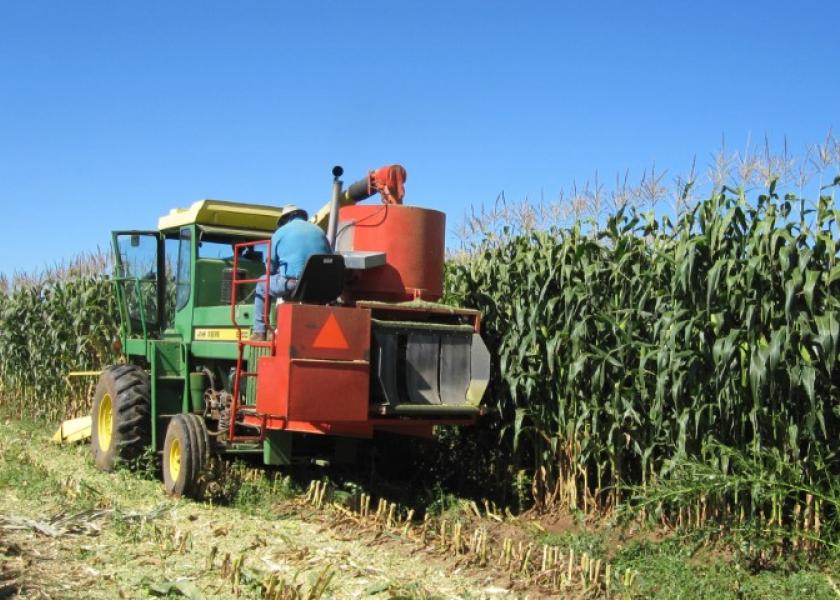Mycotoxins: Why in my silage?

By definition, silage is the preservation by fermentation of green forage. There is a reason for the inclusion of the term "green" in this definition, and this is mainly important for corn under our temperate climate. Corn is a tropical plant requiring specific heat-days to reach maturity. A freeze at the end of summer will partly kill it. The leaves take on a brown color as the cells die and stop all defense mechanisms against fungi, either phytopathogenic (organisms parasitic to the plant host) or saprophytic types (group of organisms that feed on dead plant matter). This represents a full open door for the contamination of the plant before harvest. The fungus will easily grow inside leaves and other parts of the plant, and as their cell density increases so do some of their metabolic products including mycotoxins. Corn is killed after a few hours at temperature of 32 °F, or a few minutes at 28 °F.
The living tissues of green plants have several mechanisms that will restrict the growth of fungi and other pathogenic microorganisms. These plant defense functions act like our immune system. They will recognize either the microorganism"s cell compounds or some molecules that are released during the "attack", also known as elicitors. Those protection functions restrict the growth of the fungal population. Harvesting at optimal maturity, rapidly harvesting frosted and killed corn, and avoiding ensiling dead leaves will reduce fungal contamination of silage.
Corn is a unique forage since its energy value increases with its maturity level. We now face an important dilemma as we wait for the best maturity level for our corn to obtain an optimal level of starch. While we wait, the fungi are slowly eating the sugars that are present in the plant. Fusarium graminearum (deoxynivalenol (DON, a.k.a Vomitoxin), nivalenol), Fusarium verticallioides (fumonisins), Aspergillus flavus (aflatoxins, mainly a warm weather toxin), and Penicillium verrucosum (ochratoxins) are fungi that grow on senescent or stressed corn. Outside temperatures at this time of the year do not allow for significant production of mycotoxins, but some Fusarium, Aspergillus, and Penicillium species could still produce some of their mycotoxins at temperatures around 55-60°F.
Wet and cold conditions will influence the growth of fungus. Lower temperatures will slightly reduce growth speed, but air temperatures during most days in September and early October are high enough to allow spreading of those organisms in the plant tissues. Higher humidity within the leaves and stalks contribute to this. The following mycotoxins are associated with cold and wet conditions: DON, zearalenone, T-2 toxin, and fumonisin. Most of those mycotoxins are produced by either Fusarium or Penicillium species and could be present at different concentrations, incluenced by harvest time, technique and the type of storage. Temperature and humidity are two of the important factors affecting mycotoxins on the farm.
Cutting height represents one of the controls you have on fungal contamination. The section of the stalk closer to the ground has a lower energy level and will negatively influence the energy per mass of crop harvested. This section of the plant often harbors more fungal spores or actively growing fungi. Higher chop height will also lower soil intake by the harvesting equipment. It is recommended that the minimal cut height is 8 inches. Increasing this to 12 inches will increase the energy density (0.1 MJ NEL/kg of dry matter per 10 cm) thereby improving milk yield.
Fungal contamination could also affect the silk during the growing season. This contamination will influence kernel yields but will allow for the production of specific mycotoxins related to higher temperature, mainly aflatoxins. Besides applying an optimal pest control program or using better hybrids, this contamination is hard to control.
Corn should usually gain about 0.5% dry matter units per day during September. Optimal kernel maturity level for milk production is at 50% milk. Mean dry matter level would then be around 35%. You should consider all these parameters in order to decide when will be the best time to harvest. Fungus will not wait for the best conditions.
Pascal is a silage microbiologist for Lallemand Animal Nutrition. He is stationed at Miner Institute and heading up a collaborative research arrangement between Miner Institute and Lallemand.







